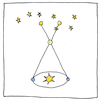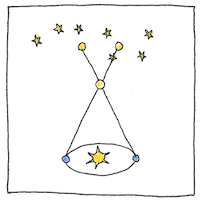Friedrich Bessel
astronomy

|
Distance to a star
To determine your distance from a star you measure the star’s apparent shift in place relative to a more distant star or galaxy as the earth moves from one side of the sun to the other, six months later. Very small shifts require very fine and stable instruments to measure. Bessel was the first to succeed using a sixteen-centimeter heliometer made by Joseph Praunhofer in Königsberg. Bessel determined that the parallax of 61 Cigni was one third of a second of an arc and with this was able to calculate our galaxy is ten light-years away.
Parallax
When, looking across the room, I move my head to the left objects near at hand shift right. When I move my head to the right objects near at hand shift left. When I walk down the hall I sway a little from side to side and enjoy the complex reverse cycloidal spiraling of doorways and trash cans as I focus on the window at the far end of the hall where, outside, green hills show through the trees.
A place in the universe
We teach that the universe is infinite because whatever we might imagine beyond it is also part of it. Love is forever, we say. We may not understand each other here and now but we hope to live in harmony hereafter. At least forty-six billion light years away beyond the edge of the observable universe is the end or the beginning or so we think.



Early astronomers such as Ptolemy taught that the stars were fixed in the heavens and revolved around us. Today to our dismay we know that we live in a violent and uncaring universe that will continue to expand beyond the reach of our instruments. We are not in the center nor is anything fixed in place.
We will always ponder our place in the universe because understanding of infinity is not biological or genetic; our experiences do not teach it; our senses do not reach it.
See also in The book of science:
Readings in wikipedia: